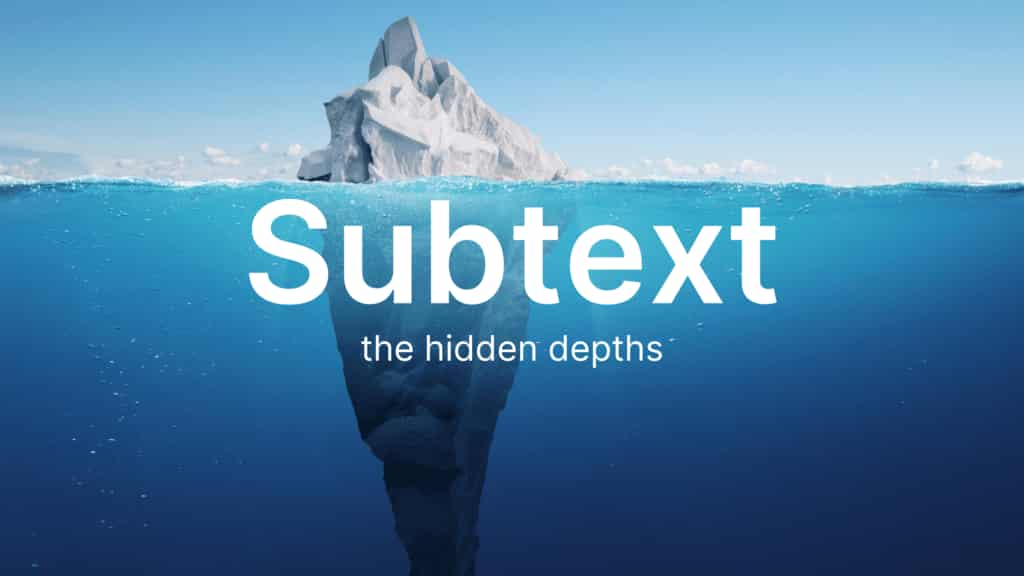Subtext is the unspoken meaning lurking beneath characters’ words and actions—the truth that exists in the space between what is spoken and what is truly meant. It’s what makes dialogue feel real, characters feel human, and stories feel layered with emotional complexity. When subtext is absent, dialogue becomes flat, predictable, and forgettable. When it’s expertly crafted, readers lean in, interpreting and analyzing every gesture, pause, and word choice.
Why Subtext Matters
Subtext transforms storytelling from simple exposition into an immersive experience where audiences become active participants. Here’s why mastering it is essential:
It Creates Authentic Communication
Real people rarely say exactly what they mean. In everyday conversations, we hint, deflect, soften, and navigate around difficult truths. When your characters speak with similar authenticity—circling around what they really feel rather than stating it directly—readers immediately recognize the truth of the interaction. A wife doesn’t say, “You think I’m fat in these jeans.” Instead, she asks, “Does my ass look fat in these jeans?”—and her husband’s reaction tells the story better than any confession could.
It Builds Dramatic Tension
When characters don’t openly express their true feelings or thoughts, uncertainty creates tension. The audience becomes engaged in deciphering what’s really happening beneath the surface. This gap between words and meaning keeps readers invested, forcing them to interpret, anticipate, and wonder. In the novel Tamar, the mother witnesses her daughter kissing a boy she disapproves of, but neither mentions it at dinner. The unspoken knowledge hangs heavy over every casual word they exchange, creating tension far more effective than an explicit confrontation.
It Conveys Multiple Layers Simultaneously
Subtext allows you to communicate character motivation, emotion, backstory, foreshadowing, and theme without resorting to clumsy exposition. A single line can simultaneously reveal a character’s fear, their desire to control a situation, their relationship dynamic with another character, and their internal conflict. This efficiency of storytelling rewards readers who pay close attention.
It Shows Respect for Reader Intelligence
When you use subtext, you’re essentially saying to your audience, “I trust you to connect the dots.” Readers appreciate being treated as intelligent partners in the narrative rather than passive recipients of information. This active engagement makes the story more memorable and meaningful.
The Trap: On-the-Nose Dialogue
Before mastering subtext, understand what to avoid. On-the-nose dialogue occurs when characters say exactly what they’re thinking. The husband responds to the jeans question with explicit honesty: “Yes, those jeans are much too tight to fit around your butt without making it look big.” The problem? It’s redundant, boring, and unrealistic.
Common signs of on-the-nose dialogue include:
Overly explicit statements where characters voice their exact emotions (“I am sad because you left me”)
Expository monologues where characters explain their motivations or backstory directly (“I grew up in Chicago, and that’s why I am tough”)
Lack of underlying meaning where dialogue reveals everything upfront without tension or ambiguity
When dialogue is too direct, it eliminates the layers that make stories engaging. The audience stops wondering and analyzing because there’s nothing left to interpret.
Types of Subtext
Understanding subtext’s dimensions helps you weave it intentionally into your work:
Emotional Subtext
The unsaid emotions conveyed through tone, gestures, facial expressions, and body language. A character might smile and nod while their shoulders tense and their jaw clenches, revealing internal conflict their words deny.
Motivational Subtext
The inference of what a character truly wants beneath their stated request. Someone says, “You know you’re my favorite person, right?” when they’re actually buttering someone up to ask a favor. The listener knows it; the reader knows it—everyone understands the real agenda.
Power Subtext
Dynamics of submission, dominance, control, and passivity. Who’s in the driver’s seat? A character who constantly interrupts, speaks over others, or controls the topic is revealing power dynamics without announcing them.
Cultural and Personal Subtext
Unspoken cultural elements and a character’s private history that inform how they speak. A video game reference, a regional accent, or an oblique allusion to a shared traumatic memory all carry subtext rooted in identity and backstory.
Psychological Subtext
Psychological processes like projection, where someone accuses another of lying precisely because they themselves have lied and feel guilty. The accusation reveals internal conflict, not external truth.
Seven Techniques to Master Subtext in Dialogue
1. Contrast Words with Actions
The most powerful subtext emerges when dialogue contradicts body language. A character expresses agreement while fidgeting nervously. They claim enthusiasm while avoiding eye contact. They say, “I’m fine,” while their hands shake.
Example:
“This is great news,” Marcus said, nodding rapidly while staring at his phone and not meeting her eyes.
The subtext here screams doubt, anxiety, or dishonesty despite his words.
2. Employ Irony and Sarcasm
Verbal irony and sarcasm involve saying the opposite of what one actually means, often to convey criticism, humor, or veiled emotion. A character might praise a terrible performance with an insincere compliment, or deflect genuine hurt with a joke. The audience hears both the surface meaning and the true meaning simultaneously.
Example from Casablanca:
“Here’s looking at you, kid.”
On the surface, a charming toast. But the subtext—longing, regret, unspoken love, resignation—transforms it into one of cinema’s most haunting lines. The delivery, context, and history between characters infuse those simple words with profound emotion.
3. Use Silence and Pauses
Sometimes what’s not said is more powerful than what is. A significant pause before responding to a question suggests hesitation, doubt, or an attempt to formulate a lie. Silence can indicate discomfort, emotional overwhelm, or the weight of an unspoken truth.
Example:
“Did you know?”
She waited, watching his expression.
He didn’t answer right away. His gaze dropped to the floor, his fingers tapping the edge of the table.
“I didn’t,” he finally muttered, but the pause spoke volumes.
The hesitation suggests guilt, uncertainty, or shame—far more effectively than if he’d answered immediately.
4. Say It Sideways or Change the Subject
Instead of addressing something directly, characters deflect or approach it tangentially. Two people in early romance don’t say, “I think I’m falling for you.” One might say, “I really enjoyed talking to you last night,” and the other catches the deeper meaning. When a character suddenly changes the subject, they’re communicating that the previous topic was too threatening or painful.
Example from Captain America:
Peggy [to Steve]: I see your top squad is prepping for duty.
Bucky: You don’t like music?
Peggy: I do, actually. I might even, when this is all over, go dancing.
Bucky: Then what are we waiting for?
Peggy: The right partner. [leaves]
Peggy’s entire exchange is about Steve, though she barely addresses him directly. The subtext about romantic partnership—and her choosing Steve—is crystal clear despite never stating it.
5. Use Metaphors and Analogies
Metaphors and analogies allow indirect expression of ideas or emotions by comparing them to seemingly unrelated concepts. Characters might compare a failing relationship to a sinking ship, or describe loss as an ocean they’re drowning in. These comparisons carry subtext because they force listeners to interpret meaning rather than receive it explicitly.
6. Leverage Character Backstory and Shared History
When characters make references or allusions to past events or shared experiences, those callbacks carry significant meaning for them—and for readers who understand the history. A seemingly casual mention of a specific date, location, or inside joke is weighted with history and emotion.
7. Create Contrast Between Words and Context
Subtext often arises from the gap between what’s said and what’s happening in the surrounding scene. A character says, “This is the best day of my life,” while standing in the rain, soaked and miserable. The irony and contrast create subtext—either the character is lying, delusional, or so resilient they find joy despite circumstances.
Practical Revision Steps
To infuse your dialogue with subtext:
Step 1: Identify On-the-Nose Lines
Read through your manuscript and underline any place where characters explicitly state what they mean. Ask: What is the point they’re trying to communicate? Are they stating it directly?
Step 2: Come at It Sideways
Now rewrite those lines to imply the same meaning without stating it. Use action, tone, irony, contrast, or subject-shifting. For instance, instead of a character saying “I’m nervous,” show them tapping their foot or avoiding eye contact.
Step 3: Add Physical Layers
Every dialogue exchange should have accompanying body language, facial expression, or environmental interaction. These physical elements communicate subtext and make dialogue more vivid.
Step 4: Read Aloud
Hearing dialogue can reveal whether it feels natural or stilted. Real conversation has rhythm, pauses, interruptions, and hesitations. Your written dialogue should mirror that authenticity.
Step 5: Trust Your Reader
Don’t over-explain. Give readers enough clues to pick up on the subtext without spelling it out. The best subtext is sophisticated enough to require interpretation but clear enough that readers understand it when they think about it.
Iconic Examples of Subtext
Breaking Bad – “I am the one who knocks.”
Walter White’s assertion is ostensibly about his role as family protector. But the subtext reveals something far darker: his growing ego and moral corruption. He’s no longer protecting his family—he’s asserting dominance fueled by criminal power. The chilling delivery and context transform this simple line into a confession of his transformation.
The Godfather – “It’s not personal, Sonny. It’s strictly business.”
Michael rationalizes a violent act as business, but the subtext shows his transformation from family outsider to someone deeply entangled in the mafia’s moral ambiguity. The line is a turning point where the audience realizes Michael has fundamentally changed.
Casablanca – The entire Rick and Ilsa dynamic
Every exchange between these characters is weighted with subtext—unspoken love, regret, and impossible choices. They’re both performing in the present while the past haunts every word.
Balancing Subtext and Clarity
The key challenge is finding the middle ground. If subtext is too subtle, readers miss it entirely. If it’s too obvious, it loses its power and becomes just another form of on-the-nose dialogue. The balance lies in giving readers enough clues to decipher the subtext without spelling it out.
Think of yourself as leaving breadcrumbs. A pause, a glance away, a comment about something seemingly unrelated, a physical gesture—each breadcrumb guides readers toward the deeper meaning without hitting them over the head with it.
Why Mastering Subtext Elevates Your Writing
Subtext is the hallmark of sophisticated storytelling. It’s the difference between writing that tells readers what to think and writing that invites them to participate in meaning-making. When you master subtext, you’re no longer relying on exposition, explicit emotional declarations, or clumsy reveals. Instead, you’re creating layered, nuanced scenes where every element—dialogue, action, silence, and context—communicates meaning simultaneously.
Readers remember stories with rich subtext long after finishing them because they’ve had to actively engage with the material. They’ve interpreted, wondered, and discovered. That work makes the story theirs in a way that explicit dialogue never can.


